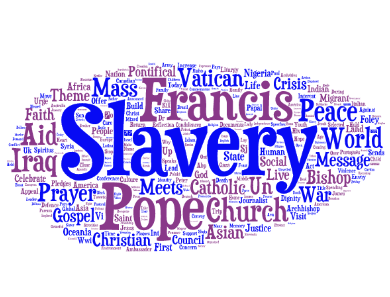 The slave trade is not a thing of the past. It is simply once again coming out of the shadows. Today we are beginning to hear a lot about trafficking, especially about sex trafficking. Pope Francis draws attention to it in his 2015 World Day of Peace message.
The slave trade is not a thing of the past. It is simply once again coming out of the shadows. Today we are beginning to hear a lot about trafficking, especially about sex trafficking. Pope Francis draws attention to it in his 2015 World Day of Peace message.
Human trafficking was by no means unknown to St. Vincent.
The seventeenth century witnessed the birth of the slave trade which systematically siphoned native Africans from their homelands in sub-Saharan Africa to cultivate the fields of Colonial America. At the same time a centuries-old slave trade flourished in North Africa.
Recently the Soroptimist web site states…
A $32 billion annual industry, modern day trafficking is a type of slavery that involves the transport or trade of people for the purpose of work. According to the U.N., about 2.5 million people around the world are ensnared in the web of human trafficking at any given time.
Human trafficking impacts people of all backgrounds, and people are trafficked for a variety of purposes. Men are often trafficked into hard labor jobs, while children are trafficked into labor positions in textile, agriculture and fishing industries. Women and girls are typically trafficked into the commercial sex industry, i.e. prostitution or other forms of sexual exploitation.
Not all slaves are trafficked, but all trafficking victims are victims of slavery. Human trafficking is a particularly cruel type of slavery because it removes the victim from all that is familiar to her, rendering her completely isolated and alone, often unable to speak the language of her captors or fellow victims.
Vincent certainly encountered human trafficking. In the seventeenth century Tunis, Algiers, Tripoli and Morocco provided bases for pirates to prey on the Christian merchant ships in the Mediterranean Sea. The Christians faced the grim fate of all those ever held in the thralldom of slavery. Their captors deprived them of their human dignity.
The slave’s only hope of escape lay in apostasy or ransom.
St. Vincent de Paul and his followers sought to minister to the slaves in North Africa during this century.
At this time, it was thought that the best way to assure the safety of the slaves was by ransom. The Vincentians with the cooperation of the consuls devoted great energy to this task. It is estimated that between 1645 and 1661 they ransomed 1200 slaves.
Father Richard Kehoe, CM provides some insights with his historical overview of “St. Vincent and the Slaves in Barbary“.
If you found his article a helpful insight into St. Vincent, see other articles written for law students by Fr. Kehoe in the Vincentian Encyclopedia.







Thank you for this inspiring, informative article affirming our current efforts to confront this human scourge in our world today.
Thank you for this very informative and inspiring article